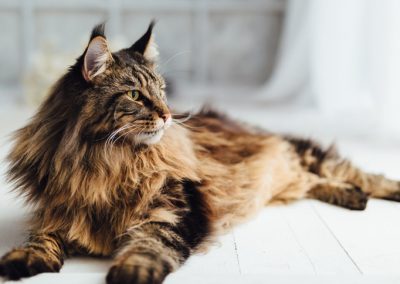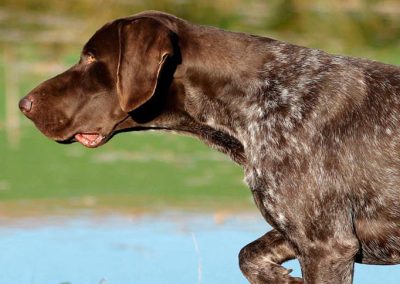
The Complex Surgical Case
“Matilda” Jones is a 4 year old Maine Coon cat, who came in to us last year. She had not been well for a while, had been sick and had been refusing to eat for several days.
Unfortunately, the trouble was that Matilda hated going to the vet. She has a sweet nature at home, and is a loving family pet, but as soon as the box comes out she gets VERY stressed. When she arrived in the consulting room she was both stressed AND grumpy! Clinical examination was fraught with difficulty, and sometimes felt like you were taking your life in your own hands, but luckily the owners were understanding of the situation. With a bit of patience we established that she was unwell enough to require being admitted, and she was taken into the hospital for nursing care, medication and being encouraged to eat. Baseline blood tests were pretty unremarkable, but despite some early success she really did not regain her appetite. After a couple of days, this was becoming more and more concerning, so her owners were contacted and consent was gained for sedation and further work-up.
When Matilda was asleep and relaxed, clinical exam became much easier. Unfortunately a worrying lump could now be felt in her abdomen, suspicious of being part of the bowel. X-rays were taken, and even worse news was to follow. There was a worrying shadow in her lungs, obscuring her heart from view. She was a bit too young to have a nasty tumour, and things didn’t look quite right for this diagnosis, but this was definitely not normal. Given the lump in her belly, we either had two unrelated conditions, or if they WERE linked in some way it would not be good news as too much of the body was affected. Having talked through the options, the owners and I elected to proceed with surgery to establish the diagnosis and see if anything could be done to save her.
Having had some time to prepare, she was put under a general anaesthetic, closely monitored by Elaine Hawley. Fluids and resuscitation drugs were on hand if required, she was intubated, and with some trepidation surgery was started and her abdomen opened. We did not truly know what we were going to find, but were in for a bit of a shock.
There WERE two separate conditions. The abdominal mass was an intersusseption, which happens when two bits of gut telescope one inside each other. The inner layer of gut has its blood supply compromised, so it starts to die off and leak toxins into the system, similar if we had a ruptured appendix. Thankfully the gut on either side of the damage appeared healthy, although was undoubtedly suffering from having no food for several days. I was able to perform an end-to-end anastomosis, a surgical procedure with allows you to remove the section of gut that is compromised and stitch the remaining intestine together. In this way, we took out about 15cm of damaged tissue, and gave the cat a fighting chance.
The shadow in the chest was a real shock. Matilda had been born with a hole in her diaphragm, the muscular sheet which separates the chest from the belly. Part of her liver had poked through this hole, and entered the sack which surrounds the heart, which was just visible in the darkness. This hernia had not been causing her any discomfort long term, but was of suddenly grave concern during her surgery. Would the pressure change on opening her abdomen cause her lungs to collapse, as would happen if there was communication with the chest cavity? One glance at the hole was enough to show us that it was beyond our capability to fix, but would its existence compromise the rest of our surgery? Natalie was called in on standby to use the anaesthetic machine to breath for her if necessary while the gut surgery was completed successfully.
Thankfully the hernia wrapped around her heart but did not involve the lungs, so there was no crisis after all, and an uneventful recovery was made. Matilda was transferred to the Glasgow University Vet School for round the clock, 24 hour intensive care, and spent several days at the hospital being fed via stomach tube and drip and closely monitored. She did extremely well, with no complications from her major operation, and went on to make a full recovery.
The specialist surgical team at the University continue to monitor her hernia, as having had a long discussion with her owners it has been felt it would be better left alone. Even some of the best surgeons in the country feel that the complication rate and the risks involved in the repair are too great at this stage, and she remains a happy and healthy cat despite having this problem under the surface.
We always look forward to seeing Matilda back at the practice, although unfortunately I suspect that she would not say the same of us! Despite her opinion, the owners and I are grateful for the way things have gone, the work put in by all involved in her care, and take great satisfaction in a job well done.
THESE CASE REPORTS REFLECT REAL ANIMALS AND EVENTS IN THE PRACTICE. PERMISSION WAS GAINED FROM THE OWNERS INVOLVED TO USE THE DETAILS OF THEIR ANIMAL’S CARE PRIOR TO PUBLICATION; HOWEVER I HAVE ALTERED THE NAMES AND SOME OTHER DETAILS TO MAINTAIN CONFIDENTIALITY.
5 Windsor Place, Bridge of Weir, PA11 3AF
T: 01505 690536 | F: 01505 690300
E: reception@kerrvetgroup.com
12 Thornhill, Johnstone, PA5 8JG
T: 01505 323331 | F: 01505 690300
E: reception@kerrvetgroup.com
If you have an emergency when we are closed, then please phone 0845 850 2080 (This number is available 24/7)



